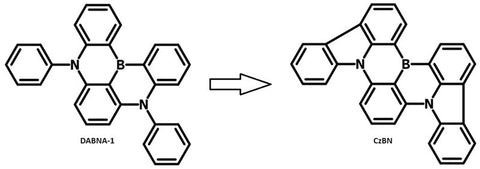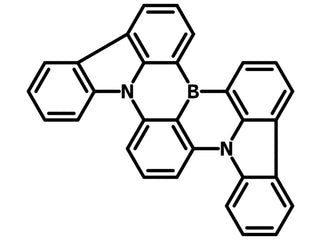CzBN
CAS Number 2170487-27-9
Blue Dopant Materials, Dopant Materials, High Purity Sublimed Materials, Materials,Blue Dopant Material with Boron-based Triarylamines
High purity sublimed narrowband multi-resonance TADF emitter for highly efficient OLEDs, Indolo[3,2,1-de]indolo[3',2',1':8,1][1,4]benzazaborino[2,3,4-kl]phenazaborine, CAS No. 2170487-27-9, Sublimed ≥99.0%
CzBN is closely related to DABNA-1 in structure. The only difference being is that the two phenylamines on each side of the DABNA-1 structure are joined to form two side carbazolyl substructures. As a result, CzBN is conjugated with a triphenyl boron core and it is believed that the formed carbazolyl groups extend the π-conjugation and increase the intramolecular charge transfer localization area for a greater multiresonance effect.
CzBN can also be considered as a derivate of 1,3-bis(N-carbazolyl)benzene (mCP), one of the most widely used host materials in OLED devices.

Due to the conjugation, CzBN is relatively red shifted in absorption and emission when compared to DABNA-1. CzBN has an absorption band at around 470 nm and narrow emission band at 479 nm with FWHM of 30 nm in dilute dichloromethane solution and PLQYs of 87%.
A solution processed sky-blue multiresonance TADF OLED device, based on 5 wt.% CzBN in a CzAcSF host, exhibited a maximum current efficiency of 24.3 cd/A, a power efficiency of 15.9 lm/W, and an external quantum efficiency of 14.7%. This is a device efficiency improvement when compared to the vacuum-deposited OLEDs based on DABNA-1.
General Information
| CAS Number | 2170487-27-9 |
|---|---|
| Chemical formula | C30H17BN2 |
| Molecular weight | 416.28 g/mol |
| Absorption* | λmax 470 nm (in DCM) |
| Fluorescence | λem 479 nm (in DCM) |
| HOMO/LUMO | HOMO = 5.62 eV, LUMO = 2.91 eV (ΔEST = 0.12 eV) |
| Synonyms | Indolo[3,2,1-de]indolo[3',2',1':8,1][1,4]benzazaborino[2,3,4-kl]phenazaborine |
| Classification or Family | Triarylamine derivatives, Tryphenylboron, Blue dopant, Multiresonance thermally activated delayed fluorescent (MR-TADF), Sublimed materials. |
Product Details
| Purity | Sublimed* >99% (HPLC) |
|---|---|
| Melting point | - |
| Appearance | Yellow powder/crystals |
* Sublimation is a technique used to obtain ultra pure-grade chemicals, see sublimed materials for OLED devices.
Chemical Structure

Device Structure(s)
| Device structure | ITO/PEDOT:PSS (40 nm)/CzAcSF:5 wt.% CzBN (50 nm)/DPEPO (10 nm)/TmPyPB (35 nm)/Liq (1 nm)/Al [1] |
|---|---|
| Color |
|
| Max Current Efficiency | 24.3 cd/A |
| Max Power Efficiency | 15.9 lm/W |
| Max EQE | 14.7% |
| Device structure | ITO/HAT-CN (10 nm)/Tris-PCz (30 nm)/mCBP (5 nm)/mCBP:20 wt% TPh2Cz2DPhCzBN*:0.5 wt% CzBN (30 nm)/SF3-TRZ (10 nm)/SF3-TRZ:30 wt% Liq (20 nm)/Liq (2 nm)/Al (100 nm) [2] |
|---|---|
| Color |
|
| Max. Luminescence | 49,933 cd/m2 |
| Max Current Efficiency | 38.3 cd/A |
| Max Power Efficiency | 40.1 lm/W |
| Max EQE | 20.6% |
*For chemical structure information, please refer to the cited references.
MSDS Documentation
Literature and Reviews
-
Solution-processed multi-resonance organic light-emitting diodes with high efficiency and narrowband emission, S. Xu et al., Chinese Chem. Lett., 32, 1372–1376 (2021); DOI: 0.1016/j.cclet.2020.10.022.
-
Investigating HOMO Energy Levels of Terminal Emitters for Realizing High-Brightness and Stable TADF-Assisted Fluorescence Organic Light-Emitting Diodes, Adv. Electron. Mater., Y. Lee et al., 7 (4), 2001090 (2021); DOI: 10.1002/aelm.202001090.
-
Narrowband Emissive Thermally Activated Delayed Fluorescence Materials, H. Kim et al., Adv. Opt. Mater., 10, 2201714 (2022); DOI: 10.1002/adom.202201714.
